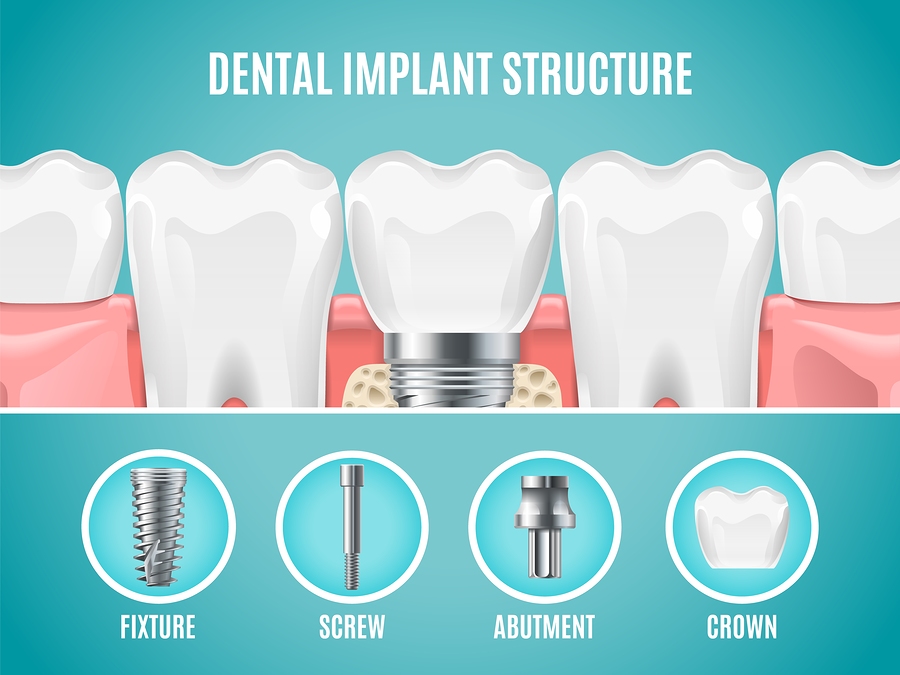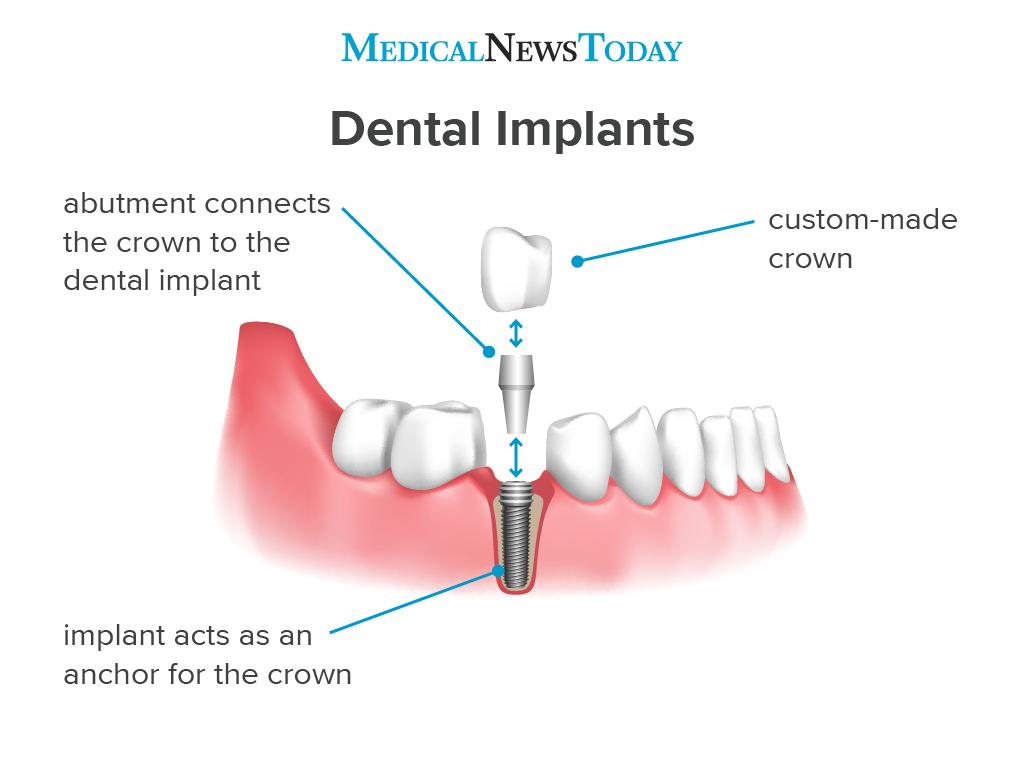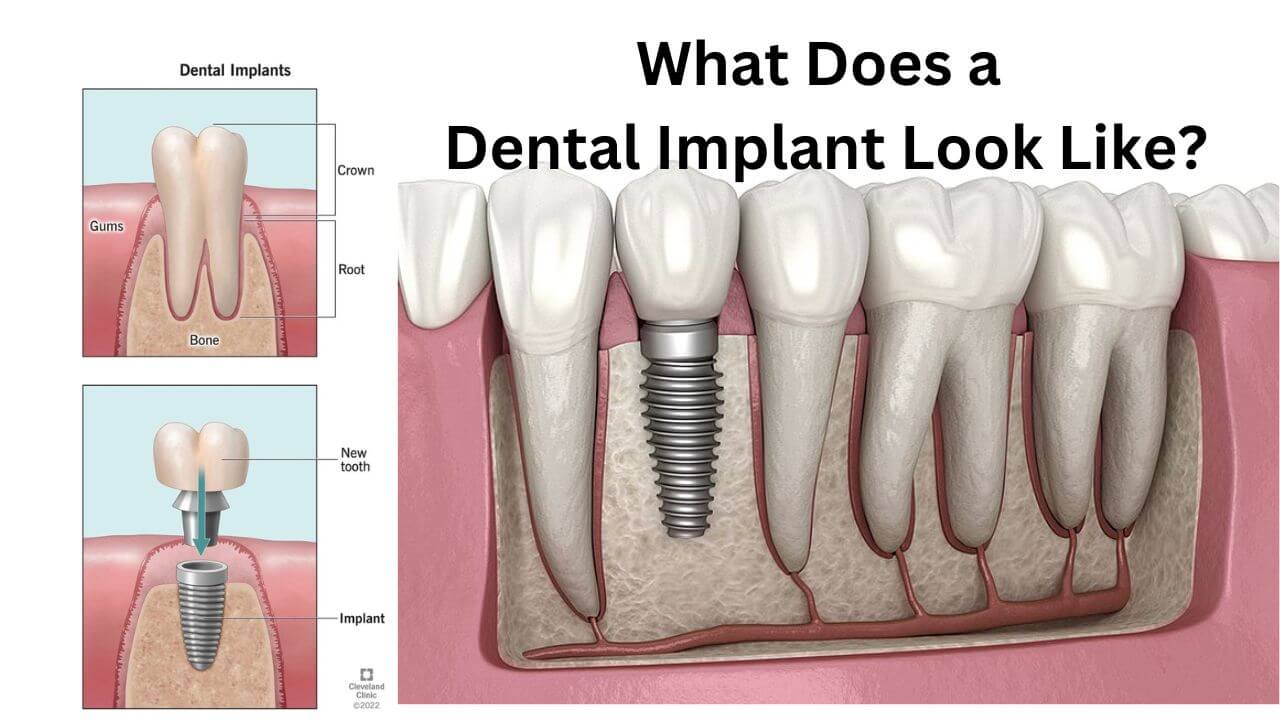A dental implant resembles a small, metallic screw, typically made of titanium. It’s designed to integrate with the jawbone, acting as a root for artificial teeth.
Dental implants have revolutionized restorative dentistry, offering a durable solution for missing teeth. They provide a strong foundation for fixed or removable replacement teeth, tailored to match your natural teeth. Implants not only restore the aesthetics of a smile but also preserve facial structure and improve oral health.
The surgical component lies beneath the gum line, while the visible part, the crown, is crafted to blend seamlessly with the rest of your teeth. This fusion of form and function makes dental implants popular for those seeking to regain a complete and confident smile. As an advanced dental technology, implants promise a high success rate, making them a reliable long-term investment for oral care.
Introduction To Dental Implants

Credit: en.wikipedia.org
Components Of A Dental Implant
Understanding the components of a dental implant is critical to appreciating this innovative solution for missing teeth. A dental implant is a high-tech replacement tooth mimicking the whole tooth structure. Let’s examine the three main parts of a dental implant: the implant itself, the abutment, and the crown.
The Implant
The implant acts as a new root for the tooth. It is a little titanium post. This metal is unique because it can fuse with bone, a process called osseointegration. The implant is placed in the jawbone by a dental professional.
The Abutment
The abutment, a connector built to support the crown, is attached to the implant. It securely holds the crown in place. After the implant fuses with the jawbone, the abutment is attached to the implant post.
The Crown
The crown is the part of the implant that looks like a tooth. Usually, porcelain or ceramic is used to make it. The crown is custom-made to match your natural teeth. It is the visible part that gives you a beautiful smile.
The Appearance Of Dental Implants
The Appearance of Dental Implants closely resembles that of natural teeth. This design ensures they blend seamlessly with your existing teeth, enhancing both function and aesthetics.
Visual Similarity To Natural Teeth
Dental implants are crafted to look just like your natural teeth. Each implant consists of a titanium post that acts as the tooth root and a custom-made crown that sits above the gum line.
- The crown is shaped and textured to match the natural contours of your teeth.
- Colour is carefully selected to ensure the implant is indistinguishable from surrounding teeth.
Material And Color Matching
The materials used in dental implants are chosen for durability and aesthetics.
| Material | Benefits | Visual Effect |
|---|---|---|
| Titanium | Durable and biocompatible | Hidden below the gum line |
| Ceramic | Strong and stain-resistant | Mimics the shine and shade of teeth |
Colour matching is a precise process. Specialists use a shade guide to find the perfect match, ensuring the implant looks natural in your mouth.
The Surgical Procedure
The journey towards a radiant smile with dental implants is a transformative process. It starts with a detailed plan and ends with a new tooth that looks and feels natural. Understanding the steps involved can help demystify the procedure and alleviate concerns about what to expect during dental implant surgery.
Initial Consultation
Your path to dental implants begins with an initial consultation. During this meeting, your dentist will:
- Evaluate your oral health with X-rays and exams.
- Discuss the best implant options for you.
- Create a personalized treatment plan.
The Implantation Process
The actual implantation is a precise procedure. Here’s what occurs:
- The area is numbed for comfort.
- A small incision is made in the gum to access the jawbone.
- The implant, a tiny titanium post, is inserted into the bone.
- After that, the gums are sealed over the implant.
Healing And Osseointegration
After the implant is in place, the healing phase begins. This phase is crucial for success:
| Timeframe | Process |
|---|---|
| Several weeks to months | The implant bonds with the jawbone in a process called osseointegration. |
| Follow-up visits | Regular check-ups ensure healthy integration and healing. |
Patience is critical during this stage as the foundation for your new tooth is established.
Aftercare For Dental Implants
For dental implants to be successful, proper aftercare is essential. It ensures healing and longevity. Let’s explore the necessary steps to take following the procedure.
Immediate Post-surgical Care
Right after surgery, follow the dentist’s instructions closely. This care is vital to recovery.
- Avoid tough foods. Choose soft options instead.
- Ice the cheek to reduce swelling.
- Rest more and keep your head elevated.
- Take medications as prescribed.
- Do not smoke or use straws. These actions can harm the implant site.
Long-term Maintenance
For long-term care, treat your implant like a natural tooth.
- Brush twice daily with a soft-bristle toothbrush.
- Floss daily, using tools designed for implants if needed.
- Regular check-ups with your dentist are a must.
- Steer clear of sticky and hard foods that could harm the implant.
- Quit smoking, as it can weaken bone structure.

Credit: www.hovedentalclinic.co.uk
Advancements In Dental Implant Technology
The realm of dental implants is witnessing groundbreaking progress with technological advancements. These innovations enhance the effectiveness of dental implants and offer greater comfort and improved patient outcomes. Let’s explore how recent technological developments are revolutionizing how we think about dental implants.
3d Printing In Implantology
3D printing technology is a game-changer in dental implantology. This cutting-edge method allows for precise and customized implant creation, tailored to fit the unique anatomy of each patient’s mouth. The benefits of 3D printing in implantology include:
- Reduced surgery time
- Enhanced accuracy of implant placement
- Less invasive procedures
- Quicker recovery for patients
Biocompatible Materials
The use of biocompatible materials is a significant advancement in dental implants. These materials work in harmony with the body, reducing the risk of rejection and promoting better integration with the jawbone. Key highlights of biocompatible materials include:
| Material | Benefits |
|---|---|
| Titanium | Durable and robust, with a high success rate |
| Zirconia | Metal-free, hypoallergenic, and aesthetic |
Comparing Dental Implants To Other Solutions

Credit: www.medicalnewstoday.com
Personal Stories And Testimonials
Frequently Asked Questions
What Does A Dental Implant Look Like In The Mouth?
A dental implant in the mouth resembles a natural tooth’s root topped with a crown, seamlessly blending with surrounding teeth.
How Painful Is Getting A Dental Implant?
Getting a dental implant typically involves minimal pain. Local anaesthesia during the procedure keeps discomfort at bay. Post-operative soreness can be managed with prescribed pain medication or over-the-counter analgesics.
Is A Dental Implant Just A Screw?
A dental implant is more than a screw; it’s a titanium post designed to support replacement teeth, mimicking a tooth’s root structure.
What Does The First Stage Of A Dental Implant Look Like?
The first stage of a dental implant involves placing a titanium post into the jawbone, which resembles a small screw.
Conclusion
Understanding the appearance and structure of dental implants is crucial for anyone considering this therapeutic option. With a design miming natural teeth, implants offer a durable solution for tooth loss. Embrace the confidence that comes with a complete, healthy smile by exploring the benefits of dental implants.
Ready to transform your oral health? Your dentist awaits with the expertise to guide you through the journey.

Hello there! I’m here to assist you with health tips and tricks. Whether you’re looking to boost your energy, improve your sleep, or enhance your overall well-being, I’m here to guide you with strategies and frameworks that can empower you to make positive changes.
First and foremost, it’s important to understand that health is a holistic concept encompassing various aspects of physical, mental, and emotional well-being.

